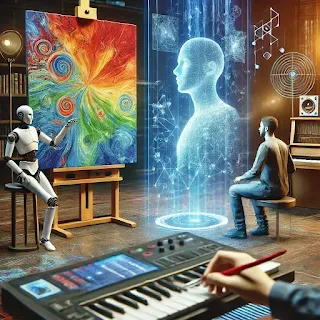AI-Driven Creativity: Transforming Music, Art, and Writing
- Get link
- X
- Other Apps
AI-Driven Creativity: Transforming Music, Art, and Writing
Artificial Intelligence (AI) has become a powerful force in the world of creativity, reshaping how we think about and create music, art, and writing. Its rapid evolution has introduced exciting opportunities and significant challenges, prompting us to rethink what it means to be creative. In this article, we’ll explore how AI is influencing these creative domains, the benefits and challenges it brings, and what the future may hold for this transformative technology.
AI in Music: Composing the Future
AI’s role in music creation has grown remarkably in recent years. By analyzing vast datasets of existing songs, AI can generate new compositions that feel fresh and innovative. Tools like OpenAI’s MuseNet are capable of creating melodies in a variety of styles, blending genres like classical and jazz effortlessly.
Benefits of AI in Music
Unlocking Creativity
AI tools help musicians experiment with new ideas, harmonies, and rhythms. This can inspire artists and open doors to unique sounds they might not have considered otherwise.Improving Efficiency
AI can automate repetitive tasks like mixing tracks or creating background music, allowing musicians to focus on the expressive aspects of their craft.
Challenges of AI in Music
Authenticity Concerns
When AI composes music, who truly owns it? And does AI-generated music carry the same emotional depth as something created by a human artist?Job Loss
As AI becomes more capable of creating music independently, there’s a growing fear that it could replace human musicians, composers, and producers.
For example, AI music tools like AIVA are now used in film scoring, creating background music without human input. While this streamlines production, it also raises concerns about diminishing opportunities for emerging artists.
AI in Art: The Rise of Digital Masterpieces
In visual arts, AI is creating entirely new kinds of artworks. Generative Adversarial Networks (GANs), for instance, analyze existing pieces to generate strikingly original images. These technologies have even produced paintings that sold for millions, such as “Portrait of Edmond de Belamy,” which was created by an AI.
Benefits of AI in Visual Arts
New Tools for Artists
AI provides artists with innovative tools, enabling them to experiment with styles, mediums, and techniques. This has led to the emergence of hybrid art forms that blend human creativity with machine precision.Accessibility
With AI-driven platforms like DALL-E, anyone can create digital art, even without formal training. This democratization of creativity allows more people to express themselves artistically.
Challenges of AI in Visual Arts
Who Owns the Art?
Determining intellectual property rights for AI-generated art is complex. Does the credit go to the algorithm, the programmer, or the user who input the idea?Value of AI Art
Some critics argue that AI art lacks the personal touch and emotional depth of human-created works, which raises questions about its cultural and artistic significance.
While AI is undoubtedly a game-changer, its role in visual arts also pushes us to rethink what we consider "real art."
 |
| AI creativity, futuristic art, AI in music and writing, creative industries transformation |
AI in Writing: Revolutionizing Words
AI has made significant strides in writing, enabling machines to generate everything from poetry to research articles. Tools like GPT-4, for example, can write essays, summarize texts, and even draft novels with impressive fluency.
Benefits of AI in Writing
Content Creation at Scale
AI can quickly generate large volumes of written content, which is invaluable for industries like journalism, marketing, and education.Brainstorming Partner
Writers often use AI to overcome creative blocks, explore different perspectives, or refine their drafts.
Challenges of AI in Writing
Quality and Originality
While AI can produce coherent text, it may lack depth or originality. Human input is often needed to fine-tune AI-generated content.Ethical Concerns
The rise of AI writing tools has led to fears about plagiarism and misinformation. Without proper oversight, these tools could be misused to spread false narratives.
For example, AI can write convincing fake news articles, which highlights the need for careful regulation.
The Ethical Landscape of AI-Driven Creativity
As AI becomes more integrated into creative fields, several ethical and societal issues arise:
Intellectual Property
AI-generated works challenge traditional notions of ownership. Clear guidelines are needed to protect creators’ rights while fostering innovation.Cultural Shifts
AI’s influence on culture prompts us to rethink the value of human creativity. Will AI enhance our artistic traditions or dilute their authenticity?Economic Impact
While AI increases productivity, it also threatens jobs in creative industries. Developing policies to address these changes is crucial to ensure equitable growth.
 |
AI-driven creativity in action: futuristic gallery featuring robotic painters, digital music composition, and holographic writing displays, highlighting human-AI collaboration |
Looking ahead, AI is likely to play an even bigger role in creative industries. We might see deeper collaborations between humans and machines, where AI acts as a partner rather than a replacement.
For example, AI could help a musician compose a symphony or assist a writer in developing characters for a novel. This synergy has the potential to unlock new heights of creativity.
However, it’s essential to navigate this future responsibly. Balancing technological innovation with ethical considerations will be key to ensuring that AI complements, rather than undermines, human creativity.
Conclusion
AI is revolutionizing music, art, and writing by providing new tools and opportunities for creators. While the technology offers numerous benefits—enhancing creativity, improving efficiency, and democratizing access—it also presents challenges that we must address.
By fostering transparency, developing ethical guidelines, and promoting collaboration, we can harness AI’s potential while preserving the integrity and value of human creativity. Ultimately, AI should serve as an ally in the creative process, amplifying our abilities rather than replacing them.
Sources:
- Get link
- X
- Other Apps




Comments
Post a Comment